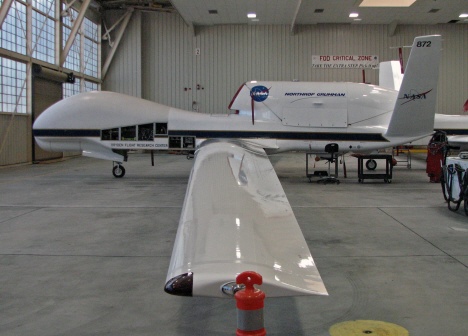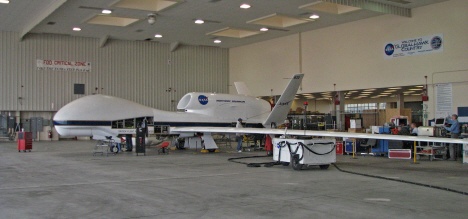

From Paul Newman, mission co-project scientist:
There is an old Latin quote: “Maxima omnium virtutum est patientia.” Or
“patience is the greatest virtue.” When it comes to mounting science instruments on an aircraft, you need to continually return to that quote.
We have 10 science instruments that we will be flying on the Global Hawk (GH). The instrument integration began as far back as 2007, with discussions between the GH operations team and the scientists.
The engineers and technicians first needed to know everything about the instruments: dimensions, weights, power usage, inlets or port location, etc. Slots for instruments were chosen, and detailed drawings of the Global Hawk and instruments were swapped between engineers and scientists. After a lot of work on technical drawings, the Dryden team began to fabricate the pallets, plates, and brackets needed to attach the instruments to the plane.
When we got here last week, each instrument was placed on a bench for an electrical test and a communications test (more about this later this week). In the 1st panel of the picture below you can see David Thomson of Droplet Measurement Technologies with the Ultra-High Sensitivity Aerosol Spectrometer (the electronics jumble in front of the computer monitor). UHSAS measures very small aerosol particles — so small that a million lined up end-to-end would only be several inches long.

In the 2nd photo, you see a mounting frame sitting on a big table-like plate. UHSAS will mount on top of this “long table” which is fixed onto the plate. After attaching UHSAS and a few other instruments, this plate will be flipped over and attached to the underside of the plane (panel 3). Then we need to run cables to connect UHSAS to the GH’s computers and power.
All of the engineering, machining, electrical work, cable running, and testing takes time. Obviously we want the best science observations, but safety comes first. We’re making progress on integrating our science instruments into the plan, but…see the first sentence of today’s post.
From Paul Newman, co-project scientist:
All of the GloPac instrument teams have now arrived at Dryden Flight Research Center, and our integration of instruments onto the Global Hawk UAS continues. We’re putting 10 instruments on the plane, and each team has 2 to 3 scientists working on their instrument.
This means we have a lot of scientists bunched around the airplane. The instrument teams are all located alongside the Global Hawk in the hangar. It’s a very spacious hangar and the lab tables are great (internet connected, and plenty of power), but it is loud and cold when the hangar door is opened.
Usually it’s just the Global Hawk crew in the hangar, so this group of
25 scientists camped around lab tables has the appearance of a gypsy
camp. Instruments, tools, computers, bicycles, food, and clothes are
piled into the instrument area. I’ll bet the crew wouldn’t be surprised if someone pulled out a mandolin and started playing.

After working in this area for a few days, the “cubicle farm offices” back home will begin to look palatial.
From Paul Newman, GloPac co-project scientist:
A flight day with the Global Hawk flight day starts very early and runs very late. For a 7 AM takeoff, the plane must be pulled out to a concrete pad adjacent to the runway at about 4 AM. This means the crew must arrive by 3 AM to get the plane ready.
The lead pilot of the Global Hawk, Dee Porter, led a meeting of the entire team this morning at 5. He reviewed the aircraft status and shared the flight plan.
The plan for today was to takeoff at 7 AM (Pacific) and fly for about 14 hours. The plane would stay in restricted airspace near Edwards Air Force Base, and a series of communications tests would be performed. About halfway through the flight, the entire crew of the Global Hawk Operations Center (GHOC) would be relieved and the plane handed off to a fresh batch of controllers.

The Global Hawk’s engine was started at about 6 AM, and the plane did indeed take off shortly after 7 AM. As I write this, the plane is cruising over central California at about 60,000 feet. If everything goes well, it should land at about 9 PM tonight.
From Paul Newman, GloPac co-project scientist:
We were planning a test flight of the Global Hawk for Wednesday (March 10), but unfortunately the wind speeds are forecast to be too strong (with gusts greater than 40 mph). You can get a feel for the problem of high winds by driving your car at 40 mph and then sticking your hand out the window. But why exactly are strong winds a problem for a plane?

The Global Hawk has a 116- foot wingspan. (For comparison, the Boeing 737-800 commercial airliner has a 113-foot wingspan). This long wing allows the Global Hawk to soar to 65,000 feet. However, like the booby bird, the Global Hawk is graceful in the air but awkward on the ground. With a heavy fuel load in the wings, a strong wind can easily tilt the wing into the ground and damage the plane. So we’ll play it carefully and wait for another day.
Sent by GloPac co-project scientist Paul Newman on March 8:

Greetings from the sunny California desert! After getting up at 4 AM
in Maryland, taking a 6-hour flight to Los Angeles, and then driving two
hours, I arrived at NASA’s Dryden Flight Research Center at Edwards
Air Force Base for the start of the Global Hawk Pacific (GloPac)
mission. Now you might imagine that the California desert would be
dry and sunny, but no. At this moment, the flat lakebed is covered in
water and the skies are cloudy (but no rain).
After arriving at DFRC, I cruised into the hangar and found a beehive of activity around the Global Hawk. Only a couple of the research scientists are here so far; they’re starting to assemble their instruments and install them onto the aircraft mounting plates. The aircraft crew is pretty busy tracking down a couple of problems with one of the computers that talks between the instruments and the ground. The crew also fueled the plane today. If you look carefully at the photo, you can see the wings drooping because of the weight of the fuel inside.
Now I’m on the two most important tasks at the start of a field mission. 1) Find the coffee pot. 2) Find the bathroom.